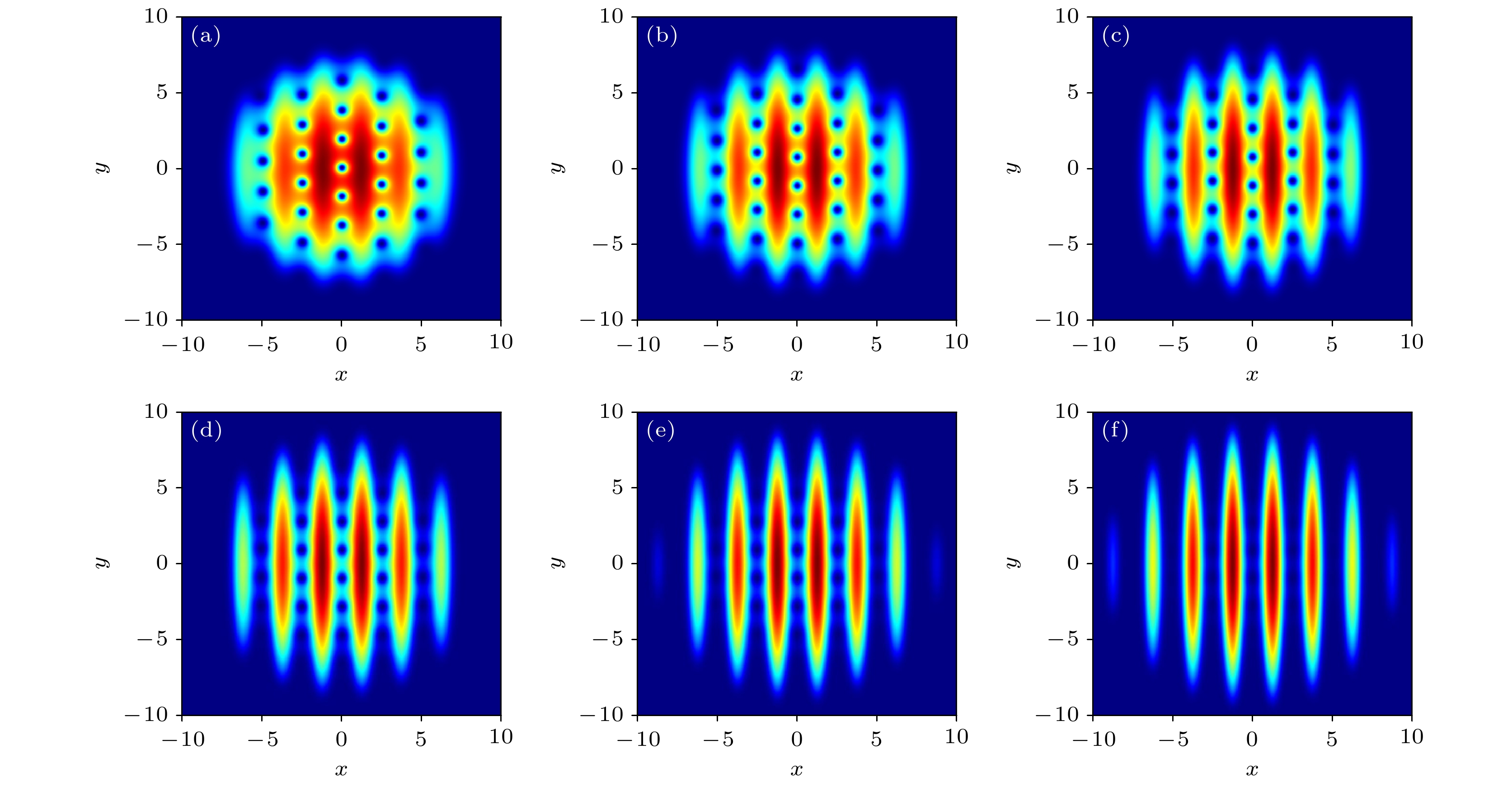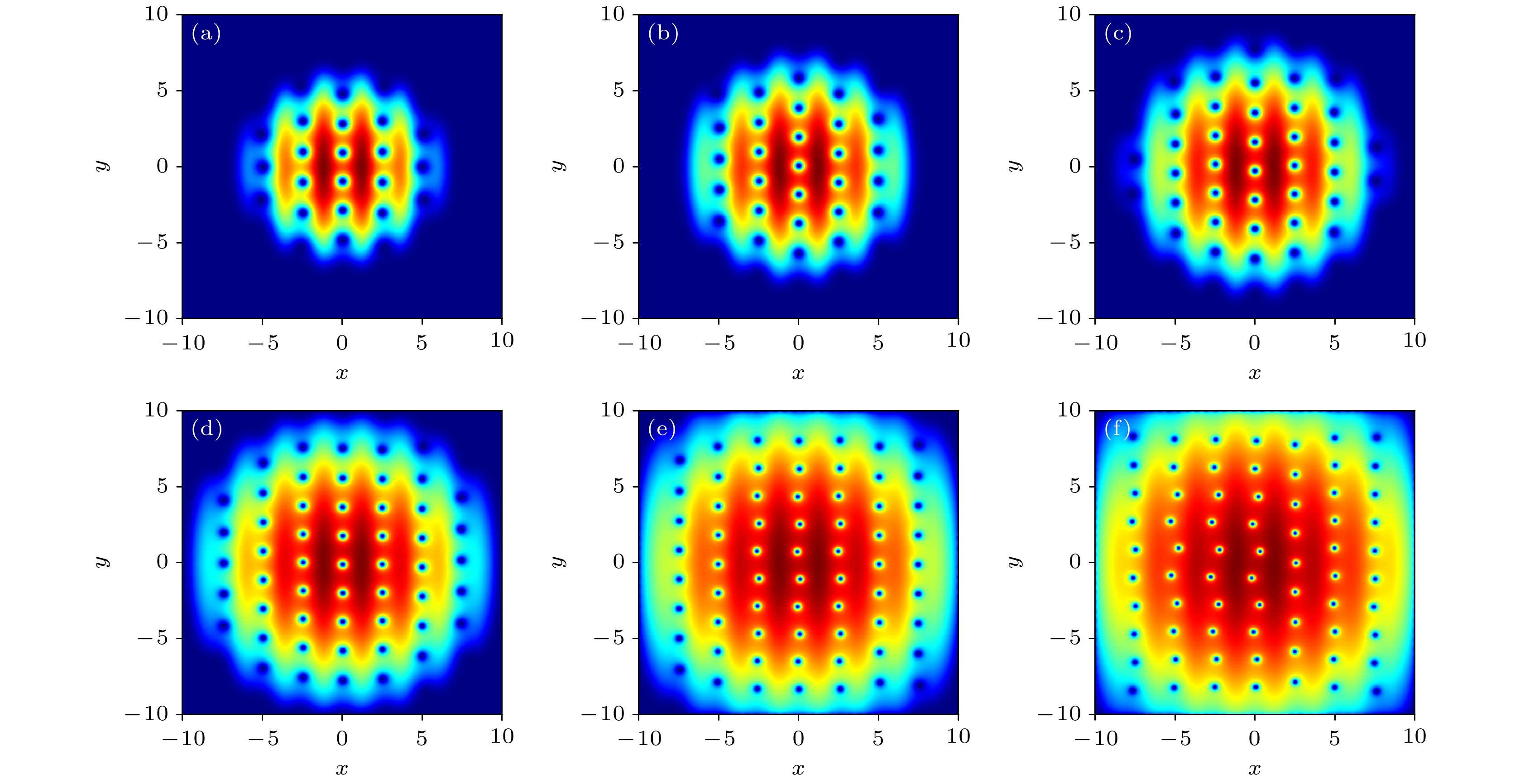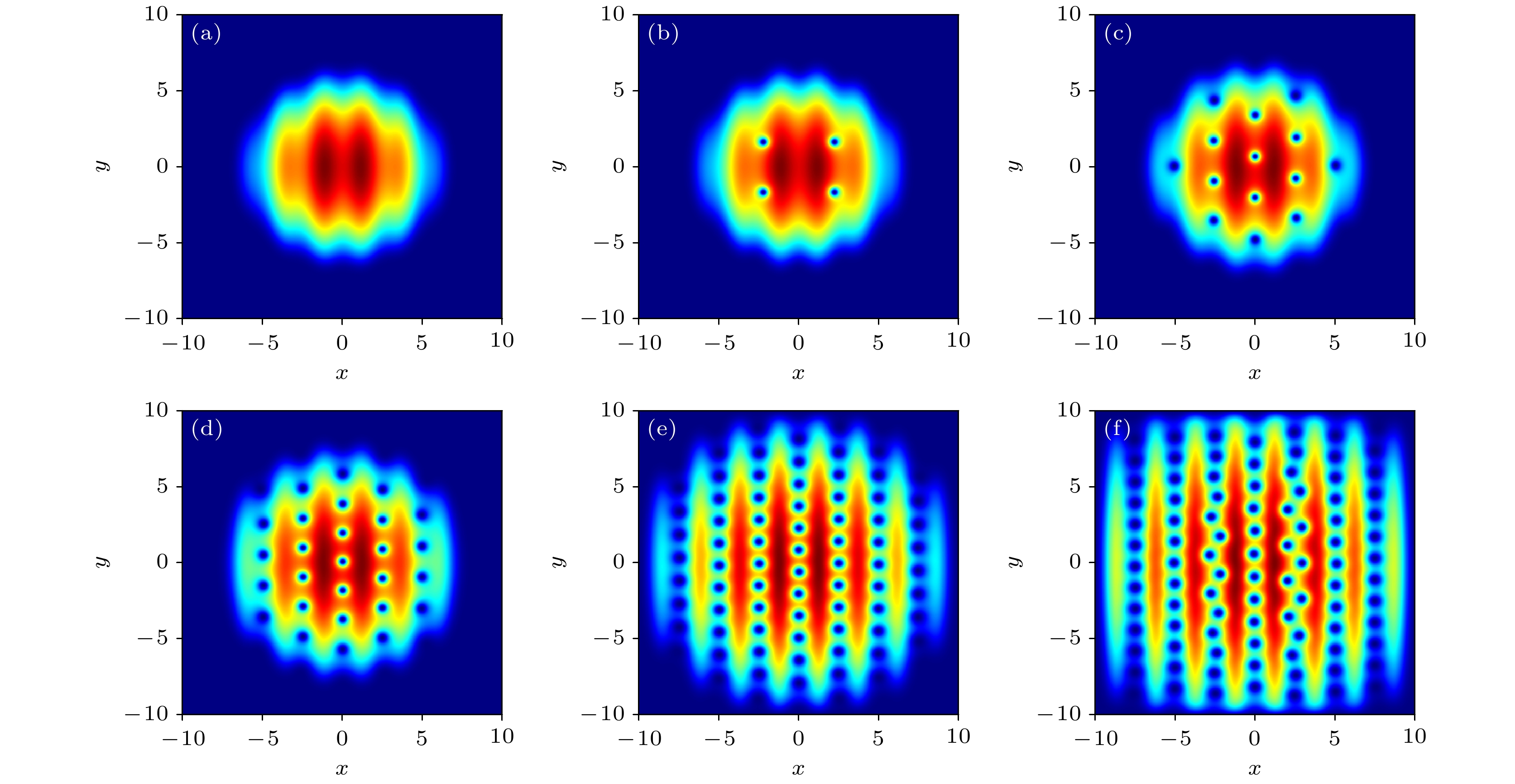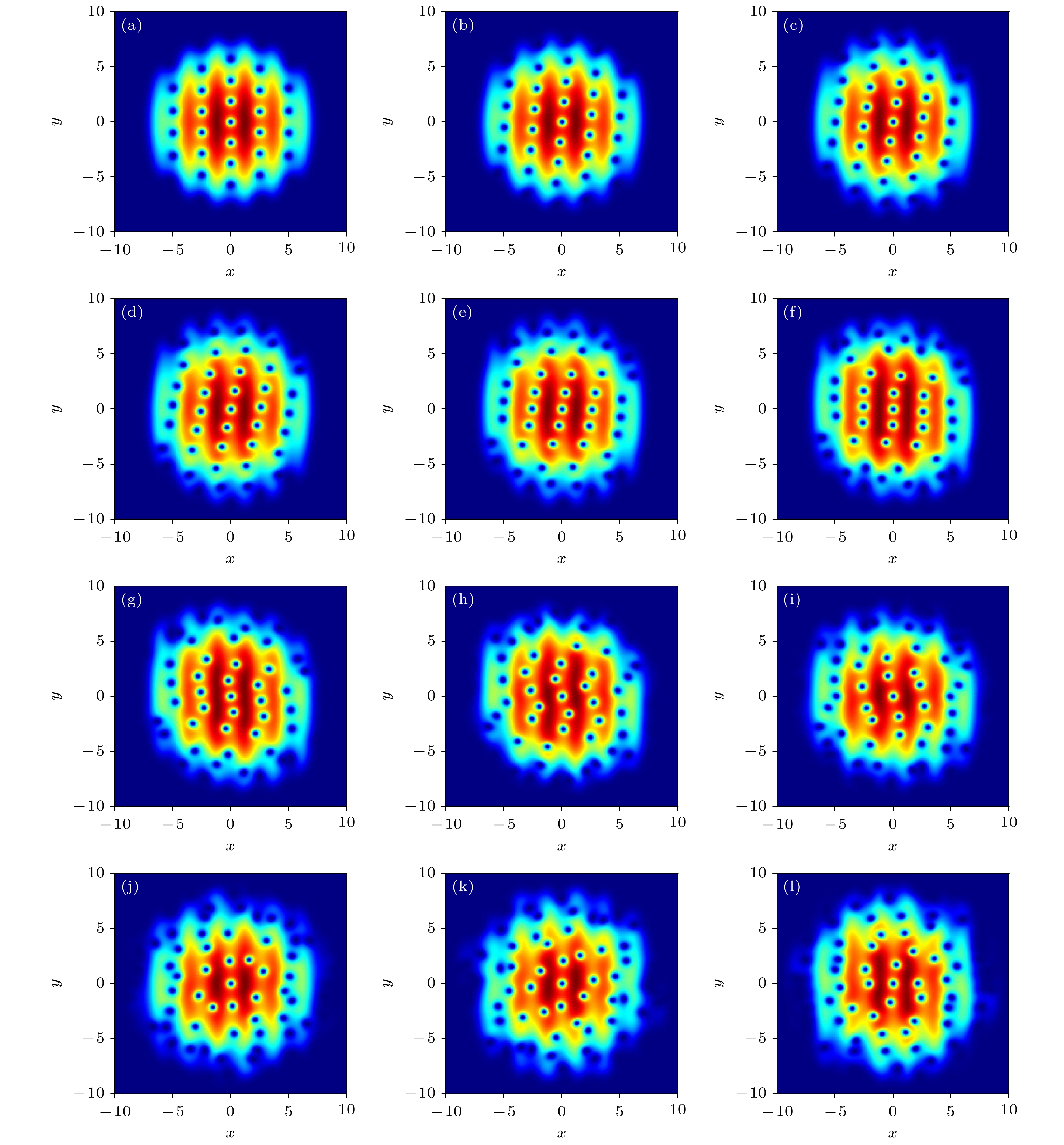-
利用数值计算方法, 研究了由简谐势与光晶格势构成的复合势阱中旋转二维玻色-爱因斯坦凝聚体中涡旋的产生、涡旋链的形成, 以及涡旋链的特性. 首先利用多重网格预条件共轭梯度法, 研究了二维凝聚体中涡旋的产生、涡旋链的形成及分布情况和不同物理参量对涡旋链的影响; 其次利用时间分裂谱方法研究了涡旋链随时间的演化情况. 结果表明, 囚禁于复合势阱的凝聚体中涡旋的产生, 对应于势阱的极小值, 当光晶格深度增大到一定值时, 凝聚体中形成了涡旋链, 而随着光晶格深度的进一步增大, 凝聚体中涡旋链中的涡旋深度不断减小, 最终涡旋链完全消失. 当原子间相互作用强度增大, 凝聚体的分布范围扩大, 凝聚体中的涡旋和涡旋链的数量也增加, 但当原子间相互作用强度增大一定值后, 涡旋链的对称性被破坏. 随着凝聚体旋转角速度的增大, 凝聚体的分布范围随之扩展, 凝聚体中涡旋和涡旋链的数量也随之增加. 当凝聚体旋转角速度接近外部势阱的谐振频率时, 涡旋链的直线排列被破坏. 还发现凝聚体中涡旋链随时间演化存在3个阶段: 第1阶段涡旋链与凝聚体一同旋转且保持原有的链状分布不变; 第2阶段出现了涡旋空间挤压现象, 涡旋链被破坏; 第3阶段出现了涡旋空间扩张现象, 最终涡旋链消失.
Bose-Einstein condensate (BEC) is essentially a macroscopic quantum effect with quantum volatility, macroscopic quantum coherence and artificial controllability. Owing to its unique controllability, it becomes a new ideal platform for quantum simulations and studies of interacting quantum systems. In this paper, the generation of vortices and the formation of vortex chains, as well as characteristics of vortex chains in rotating two-dimensional BEC in a potential composed of harmonic potential and optical lattice are studied numerically. Firstly, the generation of vortices, the formation and distribution of vortex chains and the effects of different physical parameters on the vortex chains in two-dimensional BEC are investigated by using the multigrid preconditioned conjugate gradient method. Secondly, the evolution of the vortex chains with time is studied by using the time-splitting spectral method. The results show that the generation of vortices in BEC trapped in the compound potential corresponds to the minimum value of the potential. When the depth of the optical lattice increases to a certain value, vortex chains are formed in the BEC. With the further increase of the depth of the optical lattice, the vortex depth in the vortex chain in the BEC decreases continuously, and finally the vortex chain disappears completely. When the interaction strength between atoms increases, the distribution range of the condensate expands, and the number of vortices and the number of vortex chains in the condensate also increase. When the interaction strength between atoms increases to a certain value, the symmetry of the vortex chains is broken. As the rotation frequency of the condensate increases, the distribution range of the condensate expands, and the number of vortices and the number of vortex chains in the condensate also increase. When the rotation frequency is close to the external trapping potential frequency, the linear alignment of the vortex chains is disrupted. It is also found that there are three stages in the evolution of the vortex chains in the BEC: in the first stage, vortex chains rotate together with the condensate, and the original chain distribution keeps unchanged; in the second stage, the phenomenon of vortex space extrusion appears, and the vortex chain is destroyed; in the third stage, the phenomenon of vortex space expansion occurs, and finally the vortex chains disappear. The results above show that the depth of the optical lattice, the interaction strength between atoms, and the rotation frequency of the condensate have important effects on the vortices and vortex chains in the condensate. By adjusting these physical quantities, the number of vortices and the shape of vortex chains in the BEC can be effectively manipulated. This may provide some theoretical reference and guidance for future experiments and applications. -
Keywords:
- Bose-Einstein condensate /
- vortex chains /
- optical lattices /
- composite potential
[1] Anderson M H, Ensher J R, Matthews M R, Wiemane C E, Cornell A 1995 Science 269 198
 Google Scholar
Google Scholar
[2] Bradley C C, Sackett C A, Tollett J J, Hulet R G 1995 Phys. Rev. Lett. 75 1687
 Google Scholar
Google Scholar
[3] Davis K B, Mewes M O, Andrews M R, van Druten N J, Durfee D S, Kurn D M, Ketterle W 1995 Phys. Rev. Lett. 75 3969
 Google Scholar
Google Scholar
[4] 郭慧, 王雅君, 王林雪, 张晓斐 2020 物理学报 69 010302
 Google Scholar
Google Scholar
Guo H, Wang J Y, Wang L X, Zhang X F 2020 Acta Phys. Sin. 69 010302
 Google Scholar
Google Scholar
[5] Wang L X, Dai C Q, Wen L, Liu T, Jiang HF, Saito H, Zhang S G, Zhang X F 2018 Phys. Rev. A 97 063607
 Google Scholar
Google Scholar
[6] 陈艳勃, 张素英 2020 量子光学学报 26 7
Chen Y B, Zhang S Y 2020 J. Quantum Opt 26 7
[7] 乔红霞, 张素英 2019 量子光学学报 25 319
Qiao H X, Zhang S Y 2019 Chin. J. Comput. Phys 25 319
[8] 王书松, 张素英 2021 计算物理 38 113
Wang S S, Zhang S Y 2021 Chin. J. Comput. Phys 38 113
[9] Tsubota M, Kasamatsu K, Ueda M 2002 Phys. Rev. A 65 023603
 Google Scholar
Google Scholar
[10] Li S, Prinari B, Biondini G 2018 Phys. Rev. E 97 022221
 Google Scholar
Google Scholar
[11] Yan Z, Konotop V V, Akhmediev N 2010 Phys. Rev. E 82 036610
 Google Scholar
Google Scholar
[12] 张爱霞, 姜艳芳, 薛具奎 2021 物理学报 70 200302
 Google Scholar
Google Scholar
Zhang A X, Jiang Y F, Xue J K 2021 Acta Phys. Sin 70 200302
 Google Scholar
Google Scholar
[13] 李吉, 刘伍明 2018 物理学报 67 110302
 Google Scholar
Google Scholar
Li J, Liu W M 2018 Acta Phys. Sin 67 110302
 Google Scholar
Google Scholar
[14] 陈光平 2015 物理学报 64 030302
 Google Scholar
Google Scholar
Chen G P 2015 Acta Phys. Sin 64 030302
 Google Scholar
Google Scholar
[15] Chin C, Grimm R, Julienne P, et al. 2010 Rev. Mod. Phys. 82 1225
 Google Scholar
Google Scholar
[16] Sanz J, Frölian A, Chisholm C S, Cabrera C R, Tarruell L 2022 Phys. Rev. Lett. 128 013201
 Google Scholar
Google Scholar
[17] Nguyen J H V, Luo D, Hulet R G 2017 Science 356 422
 Google Scholar
Google Scholar
[18] Di Carli A, Henderson G, Flannigan S, Colquhoun C D, Mitchell M, Oppo G-L, Daley A J, Kuhr S, Haller E 2020 Phys. Rev. Lett. 125 183602
 Google Scholar
Google Scholar
[19] Lin Y J, Compton R L, Perry A R, Phillips W D, Porto J V, Spielman I B 2009 Phys. Rev. Lett. 102 130401
 Google Scholar
Google Scholar
[20] Chen P K, Liu L R, Tsai M J, Chiu N C, Kawaguchi Y, Yip S K, Chang M S, Lin Y J 2018 Phys. Rev. Lett. 121 250401
 Google Scholar
Google Scholar
[21] Zou P, Brand J, Liu X J, Hu H 2016 Phys. Rev. Lett. 117 225302
 Google Scholar
Google Scholar
[22] Chen K J, Wu F, Peng S G, Yi W, He L Y, 2020 Phys. Rev. Lett. 125 260407
 Google Scholar
Google Scholar
[23] Katsimiga G C, Kevrekidis P G, Prinari B, Biondini G, Schmelcher P 2018 Phys. Rev. A 97 043623
 Google Scholar
Google Scholar
[24] Gligorić G, Maluckov A, Hadžievski L, Malomed B A 2013 Phys. Rev. E 88 032905
 Google Scholar
Google Scholar
[25] Balaž A, Paun R, Nicolin A I, Balasubramanian S, Ramaswamy R 2014 Phys. Rev. A 89 023609
 Google Scholar
Google Scholar
[26] Sudharsan J B, Radha R, Fabrelli H, Gammal A, Malomed B A 2015 Phys. Rev. A 92 053601
 Google Scholar
Google Scholar
[27] Kengne E, Liu W M, Malomed B A 2021 Phys. Rep. 899 1
 Google Scholar
Google Scholar
[28] Cheng Y S, Adhikari S K 2011 Phys. Rev. A 83 023620
 Google Scholar
Google Scholar
[29] Wang C, Law K J H, Kevrekidis P G, Kevrekidis G, Porter M A 2013 Phys. Rev. A 87 023621
 Google Scholar
Google Scholar
[30] Wang D S, Song S W, Xiong B, Liu W M 2011 Phys. Rev. A 84 053607
 Google Scholar
Google Scholar
[31] Yan Z Y, Konotop V V, Yulin A V, Liu W M 2012 Phys. Rev. E 85 016601
 Google Scholar
Google Scholar
[32] Antoine X, Tang Q L, Zhang Y 2018 Commun. Comput. Phys. 24 966
[33] Williams R A, Al-Assam S, Foot C J 2010 Phys. Rev. Lett. 104 050404
 Google Scholar
Google Scholar
[34] 陈海军, 任元, 王华 2022 物理学报 71 056701
 Google Scholar
Google Scholar
Chen H J, Ren Y, Wang H 2022 Acta Phys. Sin 71 056701
 Google Scholar
Google Scholar
[35] Abrikosov A A 2004 Rev. Mod. Phys. 76 975
 Google Scholar
Google Scholar
[36] Matveenko S I 2010 Phys. Rev. A 82 033628
 Google Scholar
Google Scholar
[37] Schweikhard V, Coddington I, Engels P, Mogendorff V P, Cornell E A 2004 Phys. Rev. Lett. 92 040404
 Google Scholar
Google Scholar
[38] Bao W Z, Jaksch D, Markowich P A 2003 J. Comput. Phys. 187 318
 Google Scholar
Google Scholar
[39] Bao W Z, Wang H 2006 J. Comput. Phys. 217 612
 Google Scholar
Google Scholar
[40] Fletcher R J, Shaffer A, Wilson C C, Patel P B, Yan Z J, Crépel V, Mukherjee B, Zwierlein M W 2021 Science 372 1318
 Google Scholar
Google Scholar
-
图 1 不同光晶格深度对涡旋链形成的影响 (a)
$ {V_0} = 0 $ ; (b)$ {V_0} = 0.05 $ ; (c)$ {V_0} = 0.5 $ ; (d)$ {V_0} = 1.5 $ ; (e)$ {V_0} = 3.0 $ ; (f)$ {V_0} = 4.5 $ . 其他参数设置为:$ k = 1.25 $ ,$g = 0.1$ ,$\varOmega = 0.7$ Fig. 1. Effect of the depth of the optical lattice on the formation of vortex chains: (a)
$ {V_0} = 0 $ ; (b)$ {V_0} = 0.05 $ ; (c)$ {V_0} = 0.5 $ ; (d)$ {V_0} = 1.5 $ ; (e)$ {V_0} = 3.0 $ ; (f)$ {V_0} = 4.5 $ . Values of other parameters are$ k = 1.25 $ ,$g = 0.1$ , and$\varOmega = 0.7$ .图 2 不同光晶格深度情况下, 凝聚体的密度分布
$ {\left| {\psi \left( {x, y} \right)} \right|^2} $ 的图像 (a)$ {V_0} = 3.0 $ ; (b)$ {V_0} = 6.0 $ ; (c)$ {V_0} = 9.0 $ ; (d)$ {V_0} = 15.0 $ ; (e)$ {V_0} = 21.0 $ ; (f)$ {V_0} = 30.0 $ . 其他参数与图 1 中的相同Fig. 2. The density distribution of BEC at different optical lattice depths: (a)
$ {V_0} = 3.0 $ ; (b)$ {V_0} = 6.0 $ ; (c)$ {V_0} = 9.0 $ ; (d)$ {V_0} = 15.0 $ ; (e)$ {V_0} = 21.0 $ ; (f)$ {V_0} = 30.0 $ . The other parameters used are the same as those in Fig. 1.图 3 不同原子间相互作用强度情况下, 凝聚体的密度分布
$ {\left| {\psi \left( {x, y} \right)} \right|^2} $ 的图像 (a)$ g = 0.05 $ ; (b)$ g = 0.10 $ ; (c)$ g = 0.15 $ ; (d)$ g = 0.30 $ ; (e)$ g = 0.60 $ ; (f)$ g = 0.90 $ . 其他参数设置为:$ k = 1.25 $ ,${V_0} = 3.0$ ,$\varOmega = 0.7$ Fig. 3. Density distribution of BEC for different interaction strengths between atoms: (a)
$ g = 0.05 $ ; (b)$ g = 0.10 $ ; (c)$ g = 0.15 $ ; (d)$ g = 0.30 $ ; (e)$ g = 0.60 $ ; (f)$ g = 0.90 $ . Values of other parameters are$ k = 1.25 $ ,${V_0} = 3.0$ , and$\varOmega = 0.7$ .图 4 不同旋转角速度情况下, 凝聚体的密度分布
$ {\left| {\psi \left( {x, y} \right)} \right|^2} $ 中的涡旋及涡旋链的分布情况 (a)$\varOmega = 0.1$ ; (b)$\varOmega = 0.3$ ; (c)$\varOmega = 0.5$ ; (d)$\varOmega = 0.7$ ; (e)$\varOmega = 0.9$ ; (f)$\varOmega = 0.95$ . 其他参数设置为:$ k = 1.25 $ ,$g = 0.1$ ,${V_0} = 3.0$ Fig. 4. Distribution of vortices and vortex chains in the BEC under different rotation frequency: (a)
$\varOmega = 0.1$ ; (b)$\varOmega = 0.3$ ; (c)$\varOmega = 0.5$ ; (d)$\varOmega = 0.7$ ; (e)$\varOmega = 0.9$ ; (f)$\varOmega = 0.95$ . Values of other parameters are$ k = 1.25 $ ,$g = 0.1$ , and${V_0} = 3.0$ .图 5 旋转 BEC 中涡旋和涡旋链随时间演化 (a)
$ t = 0 $ ; (b)$ t = 1.0 $ ; (c)$ t = 2.0 $ ; (d)$ t = 3.0 $ ; (e)$ t = 4.0 $ ; (f)$ t = 5.0 $ ; (g)$ t = 6.0 $ ; (h)$ t = 8.0 $ ; (i)$ t = 10.0 $ ; (j)$ t = 12.0 $ ; (k)$ t = 14.0 $ ; (l)$ t = 16.0 $ . 其他参数为$ k = 1.25 $ ,$g = 0.1$ ,${V_0} = 3.0$ ,$\varOmega = 0.7$ Fig. 5. Evolution of vortices and vortex chains of the rotating BEC: (a)
$ t = 0 $ ; (b)$ t = 1.0 $ ; (c)$ t = 2.0 $ ; (d)$ t = 3.0 $ ; (e)$ t = 4.0 $ ; (f)$ t = 5.0 $ ; (g)$ t = 6.0 $ ; (h)$ t = 8.0 $ ; (i)$ t = 10.0 $ ; (j)$ t = 12.0 $ ; (k)$ t = 14.0 $ ; (l)$ t = 16.0 $ . Values of other parameters are$ k = 1.25 $ ,$g = 0.1$ ,${V_0} = 3.0$ , and$\varOmega = 0.7$ . -
[1] Anderson M H, Ensher J R, Matthews M R, Wiemane C E, Cornell A 1995 Science 269 198
 Google Scholar
Google Scholar
[2] Bradley C C, Sackett C A, Tollett J J, Hulet R G 1995 Phys. Rev. Lett. 75 1687
 Google Scholar
Google Scholar
[3] Davis K B, Mewes M O, Andrews M R, van Druten N J, Durfee D S, Kurn D M, Ketterle W 1995 Phys. Rev. Lett. 75 3969
 Google Scholar
Google Scholar
[4] 郭慧, 王雅君, 王林雪, 张晓斐 2020 物理学报 69 010302
 Google Scholar
Google Scholar
Guo H, Wang J Y, Wang L X, Zhang X F 2020 Acta Phys. Sin. 69 010302
 Google Scholar
Google Scholar
[5] Wang L X, Dai C Q, Wen L, Liu T, Jiang HF, Saito H, Zhang S G, Zhang X F 2018 Phys. Rev. A 97 063607
 Google Scholar
Google Scholar
[6] 陈艳勃, 张素英 2020 量子光学学报 26 7
Chen Y B, Zhang S Y 2020 J. Quantum Opt 26 7
[7] 乔红霞, 张素英 2019 量子光学学报 25 319
Qiao H X, Zhang S Y 2019 Chin. J. Comput. Phys 25 319
[8] 王书松, 张素英 2021 计算物理 38 113
Wang S S, Zhang S Y 2021 Chin. J. Comput. Phys 38 113
[9] Tsubota M, Kasamatsu K, Ueda M 2002 Phys. Rev. A 65 023603
 Google Scholar
Google Scholar
[10] Li S, Prinari B, Biondini G 2018 Phys. Rev. E 97 022221
 Google Scholar
Google Scholar
[11] Yan Z, Konotop V V, Akhmediev N 2010 Phys. Rev. E 82 036610
 Google Scholar
Google Scholar
[12] 张爱霞, 姜艳芳, 薛具奎 2021 物理学报 70 200302
 Google Scholar
Google Scholar
Zhang A X, Jiang Y F, Xue J K 2021 Acta Phys. Sin 70 200302
 Google Scholar
Google Scholar
[13] 李吉, 刘伍明 2018 物理学报 67 110302
 Google Scholar
Google Scholar
Li J, Liu W M 2018 Acta Phys. Sin 67 110302
 Google Scholar
Google Scholar
[14] 陈光平 2015 物理学报 64 030302
 Google Scholar
Google Scholar
Chen G P 2015 Acta Phys. Sin 64 030302
 Google Scholar
Google Scholar
[15] Chin C, Grimm R, Julienne P, et al. 2010 Rev. Mod. Phys. 82 1225
 Google Scholar
Google Scholar
[16] Sanz J, Frölian A, Chisholm C S, Cabrera C R, Tarruell L 2022 Phys. Rev. Lett. 128 013201
 Google Scholar
Google Scholar
[17] Nguyen J H V, Luo D, Hulet R G 2017 Science 356 422
 Google Scholar
Google Scholar
[18] Di Carli A, Henderson G, Flannigan S, Colquhoun C D, Mitchell M, Oppo G-L, Daley A J, Kuhr S, Haller E 2020 Phys. Rev. Lett. 125 183602
 Google Scholar
Google Scholar
[19] Lin Y J, Compton R L, Perry A R, Phillips W D, Porto J V, Spielman I B 2009 Phys. Rev. Lett. 102 130401
 Google Scholar
Google Scholar
[20] Chen P K, Liu L R, Tsai M J, Chiu N C, Kawaguchi Y, Yip S K, Chang M S, Lin Y J 2018 Phys. Rev. Lett. 121 250401
 Google Scholar
Google Scholar
[21] Zou P, Brand J, Liu X J, Hu H 2016 Phys. Rev. Lett. 117 225302
 Google Scholar
Google Scholar
[22] Chen K J, Wu F, Peng S G, Yi W, He L Y, 2020 Phys. Rev. Lett. 125 260407
 Google Scholar
Google Scholar
[23] Katsimiga G C, Kevrekidis P G, Prinari B, Biondini G, Schmelcher P 2018 Phys. Rev. A 97 043623
 Google Scholar
Google Scholar
[24] Gligorić G, Maluckov A, Hadžievski L, Malomed B A 2013 Phys. Rev. E 88 032905
 Google Scholar
Google Scholar
[25] Balaž A, Paun R, Nicolin A I, Balasubramanian S, Ramaswamy R 2014 Phys. Rev. A 89 023609
 Google Scholar
Google Scholar
[26] Sudharsan J B, Radha R, Fabrelli H, Gammal A, Malomed B A 2015 Phys. Rev. A 92 053601
 Google Scholar
Google Scholar
[27] Kengne E, Liu W M, Malomed B A 2021 Phys. Rep. 899 1
 Google Scholar
Google Scholar
[28] Cheng Y S, Adhikari S K 2011 Phys. Rev. A 83 023620
 Google Scholar
Google Scholar
[29] Wang C, Law K J H, Kevrekidis P G, Kevrekidis G, Porter M A 2013 Phys. Rev. A 87 023621
 Google Scholar
Google Scholar
[30] Wang D S, Song S W, Xiong B, Liu W M 2011 Phys. Rev. A 84 053607
 Google Scholar
Google Scholar
[31] Yan Z Y, Konotop V V, Yulin A V, Liu W M 2012 Phys. Rev. E 85 016601
 Google Scholar
Google Scholar
[32] Antoine X, Tang Q L, Zhang Y 2018 Commun. Comput. Phys. 24 966
[33] Williams R A, Al-Assam S, Foot C J 2010 Phys. Rev. Lett. 104 050404
 Google Scholar
Google Scholar
[34] 陈海军, 任元, 王华 2022 物理学报 71 056701
 Google Scholar
Google Scholar
Chen H J, Ren Y, Wang H 2022 Acta Phys. Sin 71 056701
 Google Scholar
Google Scholar
[35] Abrikosov A A 2004 Rev. Mod. Phys. 76 975
 Google Scholar
Google Scholar
[36] Matveenko S I 2010 Phys. Rev. A 82 033628
 Google Scholar
Google Scholar
[37] Schweikhard V, Coddington I, Engels P, Mogendorff V P, Cornell E A 2004 Phys. Rev. Lett. 92 040404
 Google Scholar
Google Scholar
[38] Bao W Z, Jaksch D, Markowich P A 2003 J. Comput. Phys. 187 318
 Google Scholar
Google Scholar
[39] Bao W Z, Wang H 2006 J. Comput. Phys. 217 612
 Google Scholar
Google Scholar
[40] Fletcher R J, Shaffer A, Wilson C C, Patel P B, Yan Z J, Crépel V, Mukherjee B, Zwierlein M W 2021 Science 372 1318
 Google Scholar
Google Scholar
计量
- 文章访问数: 6758
- PDF下载量: 101
- 被引次数: 0













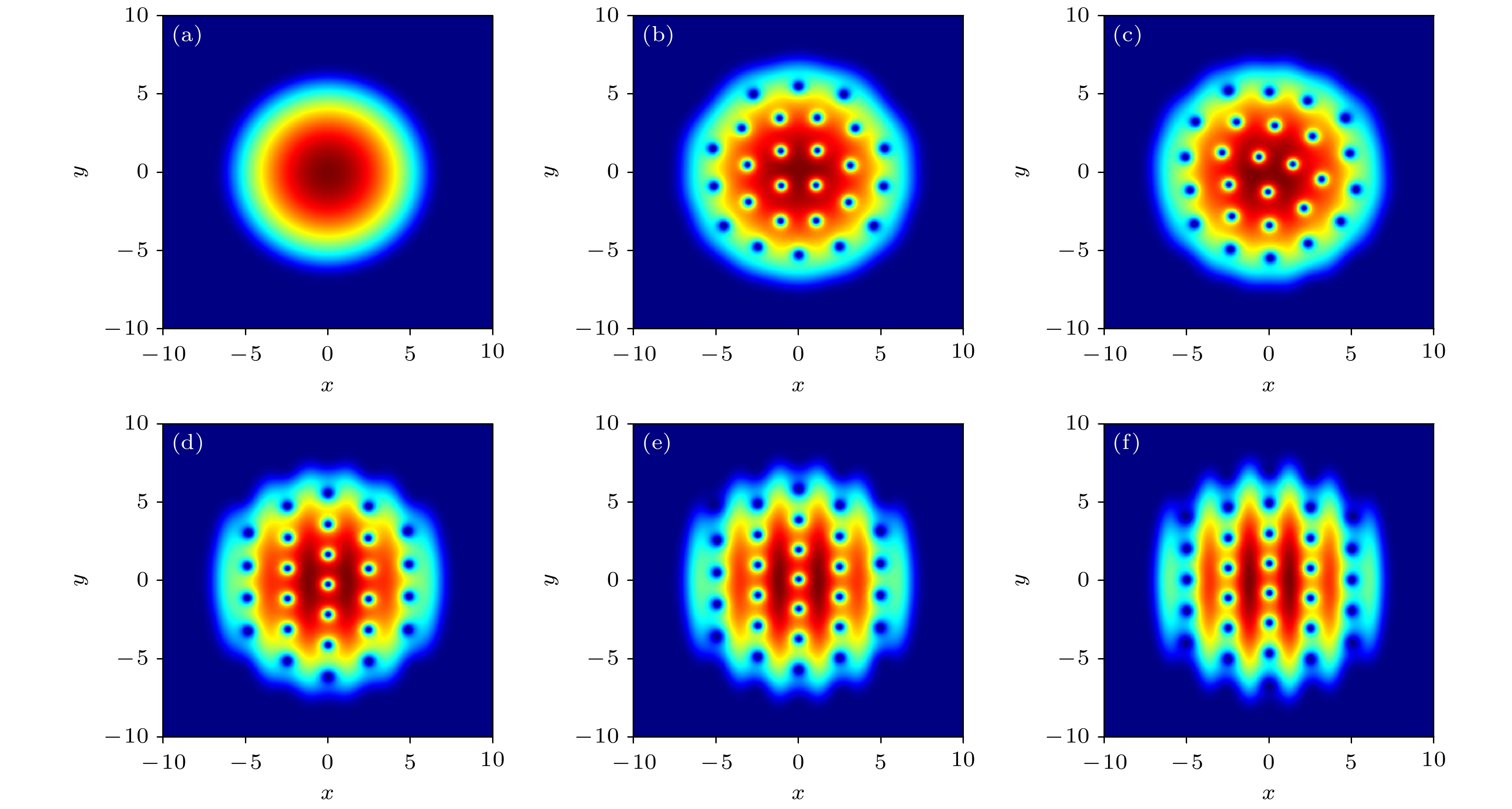


















 下载:
下载:
